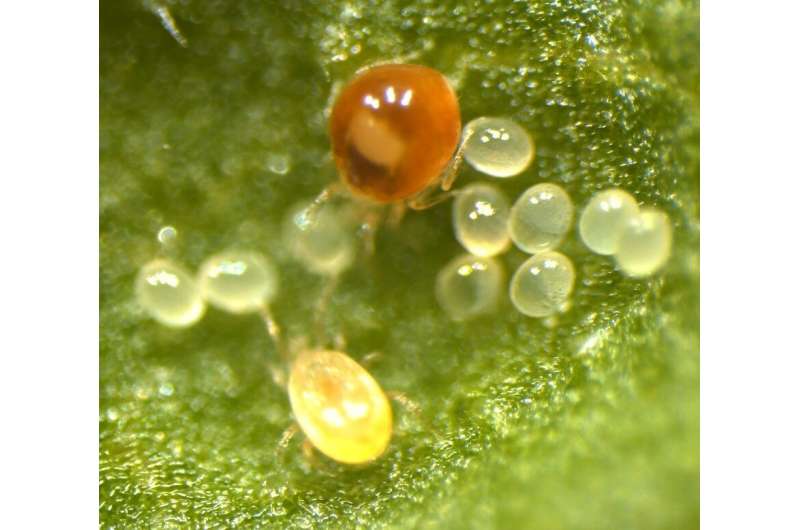This article has been reviewed according to Science X's editorial process and policies. Editors have highlighted the following attributes while ensuring the content's credibility:
fact-checked
peer-reviewed publication
proofread
Unraveling brood parasitism in predatory mites

Several animal species display brood care, a phenomenon where 'caring' parents provide their offspring with food and protection against predators. However, there are many others that prefer not to do this, and instead sneak in their eggs with those of other 'caring' species to take advantage of free brood care.
This behavior, called brood parasitism, is observed in fishes, frogs, and birds, with the most famous example being that of the cuckoo. Such brood parasitism has now also been observed in the insect world in tiny organisms called mites. Generally, brood parasitism takes a toll on the host and benefits the parasite. However, in certain circumstances, it can turn out to be costly to the parasite, thereby resulting in optional or 'facultative' brood parasitism.
Diving deeper into this, Associate Prof. Yasuyuki Choh from Chiba University, Japan, and Arne Janssen from the University of Amsterdam and the Federal University of Viçosa shed more light on factors that drive facultative brood parasitism. "In our study, we tested whether brood parasitism in predatory mites is facultatively induced by the risk of egg predation. We studied two predatory mite species that share a food source and an egg predator," says Dr. Choh. Their study was published online in Functional Ecology.
For this study, the researchers chose Neoseiulus californicus (N. californicus) and Gynaeseius liturivorus (G. liturivorus), two predatory mite species that eat western flower thrips (Frankliniella occidentalis)—an insect that is an important plant pest in agriculture. While thrips mostly consume plant tissue and pollen, they can sometimes also prey on the eggs of the two predatory mites.
This makes thrips not only prey but also egg predators of these mite species. Moreover, the adults of these two mite species also prey on each other's younger stages. Whereas G. liturivorus is known to protect its eggs by attacking and feeding on egg predators, N. californicus shows no such brood care.
Thus, the researchers tried to understand the relationship of brood parasitism between N. californicus (parasite) and G. liturivorus (host) by assessing how it affected the host, the parasite, and their respective offspring. For doing that, they observed how the two mite species interacted in the presence and absence of 1) thrips (egg predator) and 2) two-spotted spider mites (alternate prey but not an egg predator).
The researchers found that the adult female parasite preferred to lay its eggs near the host eggs, even when the adult female host was absent. But this preference was only seen in the presence of the thrips. When the thrips were replaced with spider mites, another prey of the two predatory mites that do not attack their eggs, the parasite showed no significant inclination toward placing its eggs with host eggs, indicating that brood parasitism could be conditional to the risk of egg predation.
Moreover, brood parasitism was not observed when the host eggs were replaced by eggs of another predatory mite, Phytoseiulus persimilis, which does not guard its eggs. This suggests that the parasite specifically prefers adding its eggs to guarded host eggs when egg predators are around to increase the parasite offspring's chance of survival. But this has a heavy cost on the host in terms of a higher risk of predation of its eggs by the adult female parasite.
The researchers further noted that the risk of egg predation is reversed in the absence of egg predators. When the scientists removed the thrips from the site, the adult female host could no longer feed on thrips and started attacking and feeding on the parasite offspring, making brood parasitism disadvantageous for the parasite.
Explaining the implications of this work, Dr. Choh says, "The facultative nature of the brood parasitism may not only serve to reduce costs for the parasite in the absence of egg predators but may also prevent the evolution of host behavior to avoid brood parasitism, which would result in an evolutionary arms race between parasite and host."
These findings emphasize the significance of risk associated with egg predation as a major driver for facultative brood parasitism and contribute to a better understanding of the evolution of such risk-dependent brood parasitism.
More information: Yasuyuki Choh et al, A tiny cuckoo: Risk‐dependent interspecific brood parasitism in a predatory mite, Functional Ecology (2023). DOI: 10.1111/1365-2435.14332
Journal information: Functional Ecology
Provided by Chiba University

















